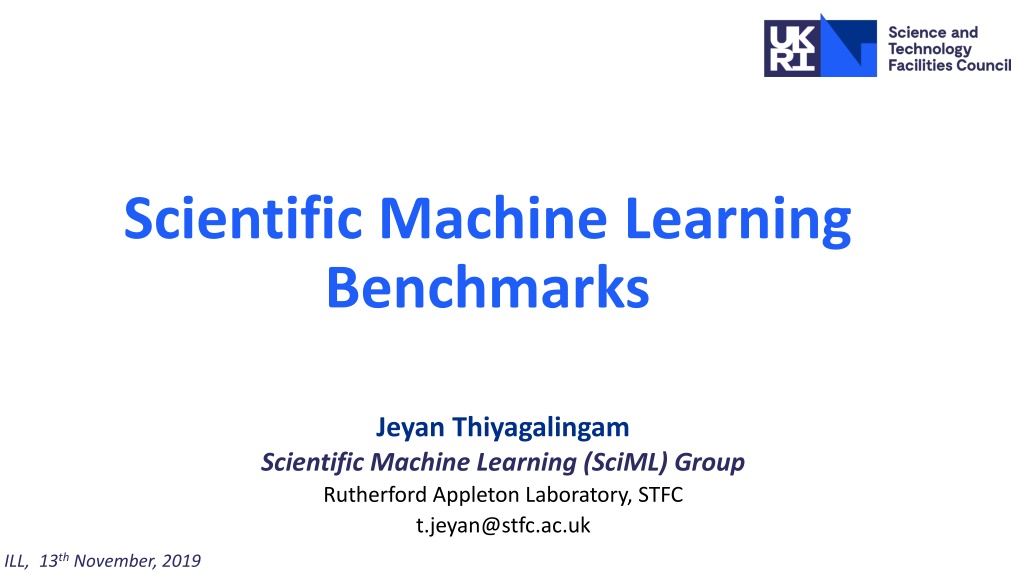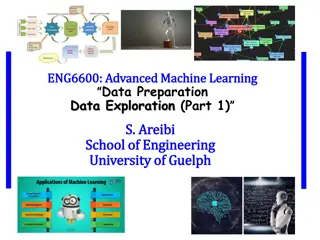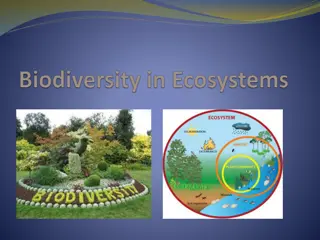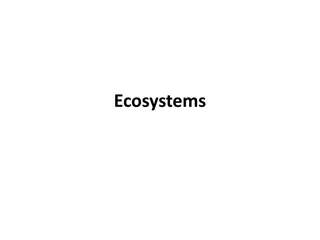Scientific Machine Learning Benchmarks: Evaluating ML Ecosystems
The Scientific Machine Learning Benchmarks aim to assess machine learning solutions for scientific challenges across various domains like particle physics, material sciences, and life sciences. The process involves comparing products based on large experimental datasets, including baselines and machine learning solutions. The objectives include evaluating hardware architectures, software frameworks, and machine learning techniques, focusing on performance metrics like runtime, energy usage, and learning efficiency with ease of usability and extensibility.
Download Presentation

Please find below an Image/Link to download the presentation.
The content on the website is provided AS IS for your information and personal use only. It may not be sold, licensed, or shared on other websites without obtaining consent from the author. Download presentation by click this link. If you encounter any issues during the download, it is possible that the publisher has removed the file from their server.
E N D
Presentation Transcript
Scientific Machine Learning Benchmarks Jeyan Thiyagalingam Scientific Machine Learning (SciML) Group Rutherford Appleton Laboratory, STFC t.jeyan@stfc.ac.uk ILL, 13th November, 2019
Benchmarking Process for comparing or assessing or evaluating different products or solutions Has existed for a long time in the computing community (and other domains of sciences) Here, we are interested on benchmarking for machine learning focused on science
Scientific Machine Learning Benchmarks 1. Motivated by specific scientific challenges from different domains Particle physics Particle classification Material sciences Small X-Ray Scattering, denoising EM images Life sciences Cell segmentation, CryoEM particle picking Environmental, earth and space sciences Etc 2. Anchored to the datasets generated by large-scale experimental facilities Large Real Open 3. Contains one or more baselines, machine learning-based solution(s)
Scientific Machine Learning Benchmarks 1. Motivated by specific scientific challenges from different domains Particle physics Particle classification Material sciences Small X-Ray Scattering, denoising EM images Life sciences Cell segmentation, CryoEM particle picking Environmental, earth and space sciences Etc 2. Anchored to the datasets generated by large-scale experimental facilities Large Real Open 3. Contains one or more baselines, machine learning-based solution(s)
Scientific Machine Learning Benchmarks 1. Motivated by specific scientific challenges from different domains Particle physics Particle classification Material sciences Small X-Ray Scattering, denoising EM images Life sciences Cell segmentation, CryoEM particle picking Environmental, earth and space sciences Etc 2. Anchored to the datasets generated by large-scale experimental facilities Large Real Open 3. Contains one or more baselines, machine learning-based solution(s)
Objectives of the ML Benchmarking Process To provide useful insight into evaluating ML ecosystems Hardware architectures (GPU, CPU, TPU, embedded GPU) Software frameworks (PyTorch, Tensorflow, Keras, etc) Machine learning techniques (DNNs, SVM, Decision Trees, etc) Network and storage components Evaluate based on multiple performance metrics: Runtime, energy, learning and inferencing performance Easy to use and extend: Just works without hefty installation process Easily extensible by end users / manufacturers Scoped for evaluating performance on multiple fronts: Classification/regression Supervised/unsupervised Little data/big data, Time constrained/unconstrained Resilience against incorrect data Different data modalities image / text Minimum data (quality vs quantity)
Objectives of the ML Benchmarking Process To provide useful insight into evaluating ML ecosystems Hardware architectures (GPU, CPU, TPU, embedded GPU) Software frameworks (PyTorch, Tensorflow, Keras, etc) Machine learning techniques (DNNs, SVM, Decision Trees, etc) Network and storage components Evaluate based on multiple performance metrics: Runtime, energy, learning and inferencing performance Easy to use and extend: Just works without hefty installation process Easily extensible by end users / manufacturers Scoped for evaluating performance on multiple fronts: Classification/regression Supervised/unsupervised Little data/big data, Time constrained/unconstrained Resilience against incorrect data Different data modalities image / text Minimum data (quality vs quantity)
Objectives of the ML Benchmarking Process To provide useful insight into evaluating ML ecosystems Hardware architectures (GPU, CPU, TPU, embedded GPU) Software frameworks (PyTorch, Tensorflow, Keras, etc) Machine learning techniques (DNNs, SVM, Decision Trees, etc) Network and storage components Evaluate based on multiple performance metrics: Runtime, energy, learning and inferencing performance Easy to use and extend Just works without hefty installation process Easily extensible by end users / manufacturers Scoped for evaluating performance on multiple fronts: Classification/regression Supervised/unsupervised Little data/big data, Time constrained/unconstrained Resilience against incorrect data Different data modalities image / text Minimum data (quality vs quantity)
Objectives of the ML Benchmarking Process To provide useful insight into evaluating ML ecosystems Hardware architectures (GPU, CPU, TPU, embedded GPU) Software frameworks (PyTorch, Tensorflow, Keras, etc) Machine learning techniques (DNNs, SVM, Decision Trees, etc) Network and storage components Evaluate based on multiple performance metrics: Runtime, energy, learning and inferencing performance Easy to use and extend Just works without hefty installation process Easily extensible by end users / manufacturers Scoped for evaluating performance on multiple fronts: Classification/regression Supervised/unsupervised Little data/big data, Time constrained/unconstrained Resilience against incorrect data Different data modalities image / text Minimum data (quality vs quantity)
Objectives of the ML Benchmarking Process To provide useful insight into evaluating ML ecosystems Hardware architectures (GPU, CPU, TPU, embedded GPU) Software frameworks (PyTorch, Tensorflow, Keras, etc) Machine learning techniques (DNNs, SVM, Decision Trees, etc) Network and storage components Evaluate based on multiple performance metrics: Runtime, energy, learning and inferencing performance Easy to use and extend Just works without hefty installation process Easily extensible by end users / manufacturers Scoped for evaluating performance on multiple fronts: Classification/regression Supervised/unsupervised Little data/big data, Time constrained/unconstrained Resilience against incorrect data Different data modalities image / text Minimum data (quality vs quantity) CNN, ResNet, mxNet, ESN, RNN, LSTM, FRCNN, etc CNN+LSTM Ensemble methods
Example Datasets Astronomy datasets from SDSS, DES, LSST, SKA, Particle Physics LHC datasets from ATLAS, CMS, DUNE, Large Scale Facilities datasets DLS, ISIS and CLF Environmental datasets from JASMIN Datasets from Culham Centre for Fusion Energy
This talk Reports a work in progress The suite & results are evolving Covers examples from: Material Sciences: Small Angle X-Ray Scattering- Particle shape identification and shape characterisation Life Sciences: Cryo-Electron Microscopy- Motion correction and denoising Environmental Sciences: Remote Sensing- Cloud masking from satellite imagery (with some detailed results) We are expanding this to cover a number of problems from other domains Astronomy: Photo-Z- Photometric Red Shift Estimation Materials: EM-Denoise- Denoising EM images And others
Example 1: Small Angle X-Ray Scattering
Small Angle X-Ray Scattering (SAXS) An X-Ray beam is scattered through the sample The beam is diffracted based on the atomic arrangement of the sample
SAXS Benchmark Challenges Particle shape identification: Given an i/q values, can we identify the basis shape? Given an i/q values, can we identify the basis shapes? Particle shape parameterisation Given an i/q values, can we parameterise the basis shapes ?
Example 2: Life Sciences Noise Filtering & Motion Correction on Cryo- EM Data
Cryo-EM Motion Correction Particles move under beam (Beam-induced motion) Perform motion correction to improve the SNR Mixed with ML-based deformable image registration and particle tracking (using Kalman filtering)
Cryo-EM Denoising The problem is to remove noise from cryo-EM images so that: Overall SNR /particle picking performance is improved, and In the absence of any known ground truth Conventional notion of training DNNs do not just work or at least is not effective
Cryo-EM Denoising The problem is to remove noise from cryo-EM images so that Overall SNR /particle picking performance is improved, and In the absence of any known ground truth
CryoEM Noise Filtering & Motion Correction Performance basis Denoising per frame Denoising over a set of averaged frames Denoising over motion corrected frames (which requires priors) Evaluation in the absence of any ground truth is challenging
Example 3: Sentinel Cloud (Detailed)
Sentinel Satellite Data: Cloud Masking Identifying cloud from satellite imagery is a core activity in environmental sciences Task 1: Each pixel (1200x1500x9) requires classification Task 2: Take the overall results further to estimate surface temperature
Cloud Identification: Some Challenges Varying conditions throughout the year Lack of good, robust and efficient cloud masking algorithms There are no spatial or time-invariant algorithms Data from multiple sensors (SLSTR, OLCI, MODIS, AASTR )
Different ML Configurations Compared UNet-128 UNet-512
Performance Results Evaluated on DGX2 (V100, 1.5TB RAM)
Focus on End-to-End Benchmarking We have not (so far) looked into the end-to-end aspects of benchmarking But our workloads have significant challenges at either end of the training and inferencing Very large datasets imply: In-memory and out-of-core data transformations Storage aspects Large amount of data transfers across nodes during learning / training Complex data wrangling and transformations These aspects need to be covered too
Challenges Distribution of datasets ? Formulation of single, projected performance metric Instead of reporting 100 different (potentially) confusing metrics we prefer one single number Ideally, folded / projected / integrated over multiple dimensions Can be controversial - the importance or significance varies how do we capture all? F1 vs runtime or Accuracy vs runtime or Accuracy vs runtime vs average energy Difficulty in measuring Some of the metrics are difficult to measure: power or energy How we do stabilize the results over stochastic nature of the results? Will the community ever learn to love pdfs? And more If you would like to contribute to the benchmark suite, please contact us
Acknowledgements SAXS: Tim Snow (Diamond) Sentinel Cloud: Samuel Jackson & Caroline Cox (RALSpace) CryoEM-Correct & CryoEM-DeNoise: Jason Yeung, Jaehoon Cha, Daiyun Huang, Jola Mirecka, Tom Burnley, Yuriy Chaban (Diamond) Photo-Z: Connor Pettitt, Ben Henges (UCL), Ofer Lahav (UCL) EM-Denoise: Patrick Austin & Keith Butler Tony Hey























